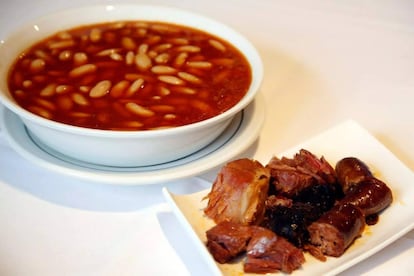How is it possible that we don’t celebrate the centenary of canned fabada with great fanfare? An invention that has saved more lazy Sundays than the microwave and ibuprofen combined: we have commemorated less justified anniversaries with great fanfare. One hundred years have passed since the Campanal company decided that a portable version of the dish was needed, which by that time was already fully established as the most traditional of Asturias.
The book tells how the fabada reached that defining, iconic moment – perhaps surpassed only by Warhol’s Campbell’s soup can – and what has happened to it since. Fabada. History and symbolism of an Asturian icon. Our colleague Pedro Zuazua had already talked about it when it was published a few months ago, but we cannot help but recommend its 170 pages, necessary, ingenious, full of data, anecdotes and beautiful old photos. A good cultural stew.
David Guardado, one of the editors and authors along with Alicia Álvarez, tells us that book sales are going as well as a fabada on a rainy day. “We notice a lot of interest among Asturians who are abroad,” he says, convinced that there will be many gifts this Christmas. “The fabada in Asturias is on a pedestal, but on the other hand the image associated with the ‘grandmother of the fabada’, a humorous issue, weighs a lot,” says David, who states that “somehow with the book I think we are giving back to the fabada part of what that image was taken away from it.”
After a hundred years of canned fabadas, it’s time to recover the ones that are still simmering. Fabada is more alive than ever and we asked the book’s editors and collaborators to advise us on which places to make a pilgrimage to eat it. There is another list, to which you can contribute your favorite in the comments section.
Casa Baizán, which opposes gentrification
Alicia and David choose Casa Baizán, in Gijón/Xixón, because “they have a delicious fabada”. It is not a place mentioned in lists of the best fabadas, nor is it a fixture in competitions for this stew. Furthermore, it is a traditional cuisine restaurant that survives gastronomic gentrification in the heart of the city, surrounded by burger chains and Asian cuisine. «We will end up eating international cuisine and it is necessary to preserve traditional cuisine», says Flor Ortea, responsible for the kitchens and of whom we are automatically fans. He follows the family recipe which “has no secrets, only good quality ingredients and a lot of love in cooking it”. In addition to the traditional recipe, it offers fabada con on request pantruquewhich is a typical ingredient of the eastern part of Asturias where his mother was originally from: “They are balls of corn flour with bacon, paprika, egg and parsley which, without frying, are placed in the fabada, they suck the fat and thicken the broth”. This needs to be tested.
Baizan House: 4 ground floor, Calle Corrida Bajo Derecha (Gijón, Asturias). tel. 985 172 745. Map.
Casa Generosa, a walk with a happy ending
In the book in question, historian and communicator Arantza Margolles writes about the evolution of the fabada as a tourist attraction. It is therefore not surprising that I recommend Casa Generosa, located in a small town in the municipality of Quirós, in the heart of Asturias. “It’s one of the most secret places for Asturians to eat fabada,” he tells us, “but I think it needs to be known.” To get to this restaurant you have two options: be a coward and go by car, or cross the Las Xanas route “which is easy to do and passes through the Torreón de Peñerúes, one of the most spectacular points in Asturias”. Always in favor of walks with a final reward in the form of delicious food.
At Casa Generosa, Enedina García spent 74 of her 80 years behind the stove. She is a queen of low gastronomy and jokes about the success of her fabada: “How can they not eat it after hitting themselves while walking.” He says he has no secrets for cooking it, although he reveals that they make compango at home, “which gives it value”. Here you eat a menu for 20 euros during the week and 22 at the weekend, and there is always a fabada to choose from.
Generous house: Pedroveya Place, 16, (Pedroveya, Asturias). tel. 985 783 046. Map.
Casa Cristina, the secret is in the black pudding
Let’s go with another winning formula House + name of the guisandera + menu that includes the fabada. In Teyego, in the municipality of Ribera de Arriba, very close to Oviedo, is Casa Cristina. “A guisander house without artifice, off the beaten track and with a constant influx,” according to the expert marketing gastronomic and agri-food Lluis Nel Estrada. In the book he talks about the new paths of fabada to conclude that the best way to find a good restaurant is by word of mouth.
Rosa Palicio succeeded her mother Cristina as head of the kitchen four years ago. It offers a 25 euro menu in which the protagonist is the fabada which appears written on half of the hundred orders that arrive in the kitchen every day. She says of her recipe that the key is in the black pudding because “that’s what gives it the most flavour”, and that’s why she orders it from a producer who makes it the way she likes it.
Casa Cristina: La Pruvía, s/n (Tellego, Asturias). tel. 985 796 251. Map.
Casa Yoli, grandmother’s recipe
One of the main revelations of the book Fabada. History and symbolism of an icon is that it anticipates by ten years the date in which the fabada is mentioned for the first time. It was in a story in the newspaper The Order in 1874 and not in 1884 as previously believed. But as the historian Xuan F. Bas indicates in his pages, the first recipe was published only in 1909 and did not include chorizo. Here’s another piece of information to keep up with your brother-in-law during your next family meal.
Xuan admits that he is not a fan of eating fabada outside because his father prepares it “superbly”. But when the time comes for the family reunion, they celebrate it at Casa Yoli, in Deva, one of the most beautiful parishes in the municipality of Gijón, and eat some potatoes with beans, chorizo, black pudding and bacon. Juan Manuel Caso takes the reins of this legendary picnic area that has almost 125 years of history. “The fabada recipe comes from my grandmother and there is nothing more mysterious than good raw materials and a little care,” he tells us before reminding us that they serve this dish to order, although some days you are lucky and can find it on the menu.
Yoli House: Carr. de Caldones, 182 (Deva, Asturias). tel. 985 368 724. Map.
La Maquina, generous with her companion
We go to Lugones/Llugones in the municipality of Siero to see how fabada is cooked in La Maquina, which is the place where the historian José Luis Carmona always takes the visitors he receives from outside Asturias to eat. “What I like is that it comes with the compango next to the plate of beans, not as is fashionable now to put a few pieces of chorizo and black pudding”, he defends and here we are always in favor of everything that is not cuqui.
Ramón González manages the restaurant and remembers with pride how his grandmother María was about to win a regional dishes competition in the 1960s in which she defended the colors of Asturias by cooking, of course, a fabada. “From that moment we specialized in the dish and it represents more or less seventy percent of the orders we receive every day,” he tells us before repeating the constant in this report, according to which the recipe he has been preparing for decades “has no secrets”. Even if we tell him that he gives “a lot of importance” to the faba, that “it must have a good flavor and at the same time be soft”. Something that, he says, “is very difficult to achieve”.

The car: Av. Conde Santa Bárbara, 59 (Lugones, Asturias). tel. 985 263 636. Map.
Casa Eladia: large faba, fatty broth and a spicy touch
Talking about the current state of fabada in the book is the foodie and creator of the blog Les Fartures David Castañón, who concludes that it is rare to find a restaurant or trattoria in Asturias where fabada is not served. You’ve tried most of them and that’s why we’re interested in your choice to eat it. Choose Casa Eladia, in Rozaes, a small town in Villaviciosa: “First-class fabada, it’s in my top three. Large faba, pure butter, with a thick broth. First-class compango, with the spicy touch of black pudding permeating the whole dish.”
An ingredient, black pudding, to which Paula Sopeña attributes great importance. “If it’s not good it ruins the fabada, if it’s not smoked well and rancea It even changes the color of the broth,” clarifies the cook of this chigre-shop, one of the few left in Asturias. We also asked her for the keys to her recipe and she surprised us by assuring us that the secret is not to pay too much attention to the cooking: “I put everything together there and the less I look at it, the better it comes out. There are people who scare them with cold water, but I don’t do any of that. In the end I only added the saffron.” Fa-ci-lí-si-mo.
House Eladia: VV-10, 23 (Villaviciosa, Asturias). tel. 665 965 605. Map.
Unfortunately we cannot write about the favorite fabada of journalist Damián Barreiro, another of the book’s authors. He died at the beginning of the year, shortly before we could read the great chapter he dedicated to ‘fabada pop’. A review of the influence of the most Asturian dish on culture. Who doesn’t remember that sketch from Martes y Trece where Covadonga is “angry”. A classic. We miss Damián but we can continue to enjoy the videos on his YouTube channel Horros & Frixuelos, no one analyzed Asturian culture with a great sense of humor like him.
And that’s it for the review of these six fabadas. It is normal that at this moment you feel the need to eat a portion of this dish. As they say in the book, “fabada melts in your mouth, even if evoked”. Remember that, even if it is far from the full experience of eating it in Asturias, at the supermarket you have some canned fabadas to satisfy your craving.
Follow El Comidista on YouTube.



